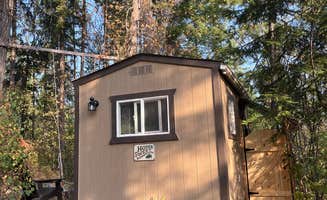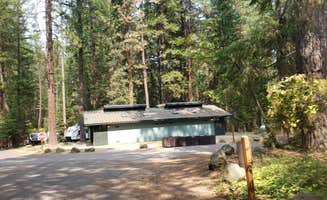Cabin accommodations near Murray, Idaho range from rustic fire lookouts to modern amenities. Located in the Silver Valley region of northern Idaho at approximately 2,300 feet elevation, the area experiences distinct seasons with snowy winters and mild summers. Cabins serve as popular alternatives to tent camping, particularly during the region's unpredictable spring and fall weather patterns.
What to do
Waterfront activities: At Camp Coeur D Alene, visitors can enjoy lake access with kayak and paddleboat rentals. "This campground was super cozy and safe. They had firewood for sale, a pool, and clean showers and bathrooms," notes one camper who appreciated the amenities while still enjoying outdoor recreation.
Hiking trails: Multiple cabin locations provide access to nearby trail systems. One camper staying at Cabins by the Joe mentioned: "There's tons of wildlife and beautiful drives and walks to be experienced here." The area offers both easy walks and more challenging wilderness hikes.
Local attractions: Some cabins serve as convenient basebases for exploring surrounding areas. A visitor to Trout Creek mentioned: "I found plenty of time to just chill while looking for a more long term spot. I did laundry at the lakeside laundry mat for less than $5 got some honey and chocolate at the gift shop, some fresh produce and essentials at the Sinclair station."
What campers like
Unique structures: The historic Gem Peak Lookout Rental offers a distinctive cabin experience. One visitor described it as "worth the drive - no hiking involved. It sits on 30 foot stilts and is stocked with plenty of firewood by the local USFS. Beautiful views of the entire Sanders County and the Clarkfork River."
Wildlife viewing: Several cabin properties feature regular wildlife sightings. A camper at By the Way Campground noted: "Was warned a Moose family likes to walk through, but didn't see them." The small campground offers both cabins and tent sites in a park-like setting.
Water features: Proximity to lakes and rivers ranks highly among camper preferences. At Heyburn State Park, campers appreciate the lake access: "Beautiful campgrounds! We biked on the Trail of the Coeur d'Alenes, saw lots of wildlife, and enjoyed the beach at Rocky Point."
What you should know
Seasonal considerations: Many cabins in the area operate seasonally. Camp Coeur D Alene runs from "May 20 to Sep 15" according to their listing, while others may close during winter months due to snow conditions.
Noise factors: Some cabins near highways experience traffic noise. One camper staying at Trout Creek Motel & RV Park mentioned: "Is a little close to highway and there are trains all night, but the whole valley is like that. Tall trees on site nice and shady."
Reservation requirements: Most cabin facilities require advance booking. Avery Creek Cabin lists reservations as mandatory, and availability can be limited during peak summer months.
Supply planning: Limited services near some cabins require advance planning. A Cabins by the Joe visitor cautioned: "It is a ways out and you better bring every thing you need because there aren't any stores close. They do have ice, on site."
Tips for camping with families
Kid-friendly amenities: Several cabin locations offer family-focused features. A visitor to Camp Coeur D Alene simply stated: "Very friendly. Great facilities!" when describing their family experience at the property.
Multi-activity sites: Look for cabins with diverse recreation options for different ages. One camper at Camp Squatch described it as a "Beautiful hideaway!" that provided both basic camping and comfortable accommodations.
Safety considerations: Families should check cabin property layouts before booking. By the Way Campground offers "about fifteen RV spots and a handful of tent sites with a fire ring. There are clean, warm bathrooms with showers and very friendly management."
Tips from RVers
Site configurations: RV travelers note the importance of checking site dimensions. One RVer at Trout Creek Motel & RV Park appreciated the "Long, pull through RV sites that are over 80 feet long" that accommodate larger rigs.
Hookup options: Cabin properties with RV sites typically offer varying levels of services. A Camp Coeur D Alene visitor noted: "Clean campground our site worked great for our Sprinter van. Site is crowded for larger pull through but it appeared to work for the campers."
Off-season benefits: Some cabin and RV properties offer year-round accessibility. Rimrock Lodge RV Park provides full hookups with proximity to town and local trail systems, making it suitable for shoulder season visits when many other facilities close.







